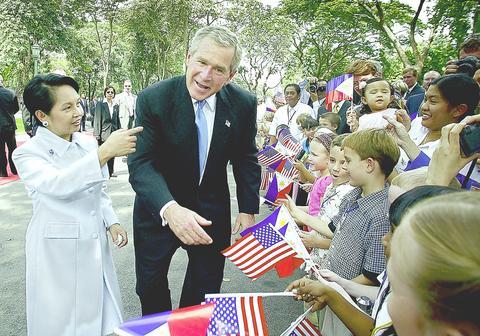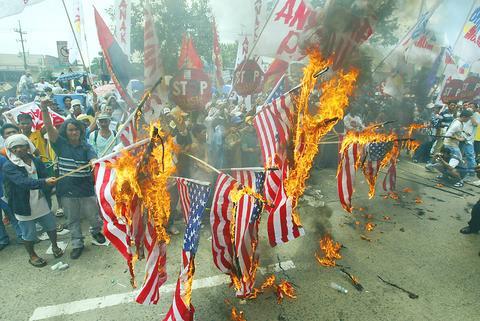Amid extraordinary security, US President George W. Bush on Saturday brought to the Philippines promises of aid to help root out al-Qaeda-linked terror groups and thanks for standing alongside US forces in Iraq.
With concerns for a possible terrorist attack high, Air Force One was escorted by a pair of US fighter jets that flew so close the pilots' faces were clearly visible from the presidential aircraft.
When Bush stepped off the plane, two girls draped a necklace of white sampaguitas, the Philippines' national flower, around his neck. Then he walked down a red carpet, past a line of military guardsmen and into his armored limousine, shipped here from Washington.

PHOTO: AFP
There were thousands of flag-waving well wishers, and even some colorful dancers in the streets, as Bush's motorcade rode by. A helicopter flew overhead, and at one point gunboats raced alongside as the procession took him along Manila Bay to a wreath-laying ceremony.
Scheduled to spend no more than eight hours here, Bush was rushing through talks with President Gloria Macapagal Arroyo, a speech to Congress and a formal state dinner before flying on to Thailand.
As he arrived, Bush got some good news from South Korea, which announced yesterday it would send an unspecified number of additional troops to help US forces rebuild and stabilize Iraq. South Korea also said it would contribute US$200 million over the next four years.

PHOTO: REUTERS
In Manila, more than 1,000 university students and other activists marched to protest Bush's visit. They waved anti-US placards and streamers saying, "Ban Bush" and "Bush No. 1 terrorist."
Thousands of riot and traffic police were deployed on major thoroughfares to keep protesters away. Many downtown roads were blocked or traffic rerouted for Bush's motorcade, causing traffic jams.
In a speech to a joint session of the Philippines' Congress, the president was to salute strengthening ties between the two nations, discuss the government's war on widespread poverty across the island chain and celebrate its progress as a democracy.
The White House decision not to spend the night here, despite the evening banquet, reflected security concerns about potential terrorism activity.
It was the second stop on a six-nation tour of Asia and Australia, a mission in which Bush is seeking support in terms of both troops and cash to help stabilize postwar Iraq and relieve American troops stationed there.
He was headed next to Bangkok to attend the annual APEC forum.
The visit to Manila was widely seen as a gesture to reward Arroyo, a US-educated economist. Earlier in the year, Bush threw a state dinner at the White House for her. The Philippines has been an early backer of US policy both in Iraq and in the broader war on terrorism, but its military is poorly-equipped and the country is the midst of an economic downturn.

Former Nicaraguan president Violeta Chamorro, who brought peace to Nicaragua after years of war and was the first woman elected president in the Americas, died on Saturday at the age of 95, her family said. Chamorro, who ruled the poor Central American country from 1990 to 1997, “died in peace, surrounded by the affection and love of her children,” said a statement issued by her four children. As president, Chamorro ended a civil war that had raged for much of the 1980s as US-backed rebels known as the “Contras” fought the leftist Sandinista government. That conflict made Nicaragua one of

COMPETITION: The US and Russia make up about 90 percent of the world stockpile and are adding new versions, while China’s nuclear force is steadily rising, SIPRI said Most of the world’s nuclear-armed states continued to modernize their arsenals last year, setting the stage for a new nuclear arms race, the Stockholm International Peace Research Institute (SIPRI) said yesterday. Nuclear powers including the US and Russia — which account for about 90 percent of the world’s stockpile — had spent time last year “upgrading existing weapons and adding newer versions,” researchers said. Since the end of the Cold War, old warheads have generally been dismantled quicker than new ones have been deployed, resulting in a decrease in the overall number of warheads. However, SIPRI said that the trend was likely

NUCLEAR WARNING: Elites are carelessly fomenting fear and tensions between nuclear powers, perhaps because they have access to shelters, Tulsi Gabbard said After a trip to Hiroshima, US Director of National Intelligence Tulsi Gabbard on Tuesday warned that “warmongers” were pushing the world to the brink of nuclear war. Gabbard did not specify her concerns. Gabbard posted on social media a video of grisly footage from the world’s first nuclear attack and of her staring reflectively at the Hiroshima Peace Memorial. On Aug. 6, 1945, the US obliterated Hiroshima, killing 140,000 people in the explosion and by the end of the year from the uranium bomb’s effects. Three days later, a US plane dropped a plutonium bomb on Nagasaki, leaving abut 74,000 people dead by the

Indian Prime Minister Narendra Modi is to visit Canada next week, his first since relations plummeted after the assassination of a Canadian Sikh separatist in Vancouver, triggering diplomatic expulsions and hitting trade. Analysts hope it is a step toward repairing ties that soured in 2023, after then-Canadian prime minister Justin Trudeau pointed the finger at New Delhi’s involvement in murdering Hardeep Singh Nijjar, claims India furiously denied. An invitation extended by new Canadian Prime Minister Mark Carney to Modi to attend the G7 leaders summit in Canada offers a chance to “reset” relations, former Indian diplomat Harsh Vardhan Shringla said. “This is a